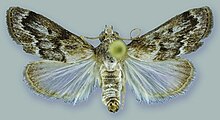Glaphyriinae
Taxonavigation
[edit]
| Taxonavigation: Pyraloidea |
|---|
|
Superregnum: Eukaryota |
Familia: Crambidae
Subfamilia: Glaphyriinae
Tribus: Cybalomiini - Dichogamini - Glaphyriini
Genera: (42)
Abegesta –
Achantodes –
Aenigmodes –
Aethiophysa –
Aureopteryx –
Bifalculina –
Catharia –
Cereophagus –
Chalcoela –
Chilomima –
Chilozela –
Clarkeiodes –
Contortipalpia –
Cosmopterosis –
Crocidolomia –
Dichochroma –
Dicymolomia –
Eupoca –
Glaphyria –
Gonodiscus –
Hellula –
Heptalitha –
Homophysa –
Homophysodes –
Lipocosma –
Lipocosmodes –
Lipocosmopsis –
Lissophanes –
Macreupoca –
Nephrogramma –
Parambia –
Paregesta –
Phyratocosma –
Plumegesta –
Psephis –
Pseudoligostigma –
Schacontia –
Scybalista –
Scybalistodes –
Stegea –
Upiga –
Vinculopsis –
Xanthophysa
Name
[edit]Glaphyriinae Forbes, 1923
Synonyms
[edit]- Evergerstinae Marion, 1952 (synonymized by Regier et al. 2012: 635).
- Noordinae Minet, 1980 (synonymized by Regier et al. 2012: 635).
- Cathariinae Minet, 1982
- Cybalomiinae Marion, 1955
References
[edit]- Regier, J.C. et al., 2012: A molecular phylogeny for the pyraloid moths (Lepidoptera: Pyraloidea) and its implications for higher-level classification. Systematic Entomology 37 (4): 635–656. Abstract: DOI: 10.1111/j.1365-3113.2012.00641.x.
- Solis, M.A. 2009: Transfer of All Western Hemisphere Cybalomiinae to Other Subfamilies (Crambidae: Pyraloidea: Lepidoptera): Elusia Schaus, Dichochroma Forbes, Schacontia Dyar, Cybalomia extorris Warren, and C. lojanalis (Dognin). Proceedings of the Entomological Society of Washington 111 (2): 493–504. Abstract: [1].
- Solis, M.A. & Adamski, D., 1998b: Review of the Costa Rican Glaphyriinae (Lepidoptera: Pyraloidea: Crambidae). Journal of the New York Entomological Society, 106 (1): 1–55. Full article: [2].
- Solis, M.A. ; M.A. Metz & D.H. Janzen, 2009: Phylogenetic Analysis of Cosmopterosis (Lepidoptera: Crambidae: Glaphyriinae) with Discussions on Male Secondary Sexual Characters and Larval Feeding on Capparis (Capparaceae) in the Pyraloidea and Lepidoptera (Insecta). Annals of the Entomological Society of America 102 (5): 766–784. Abstract: DOI: 10.1603/008.102.0504.